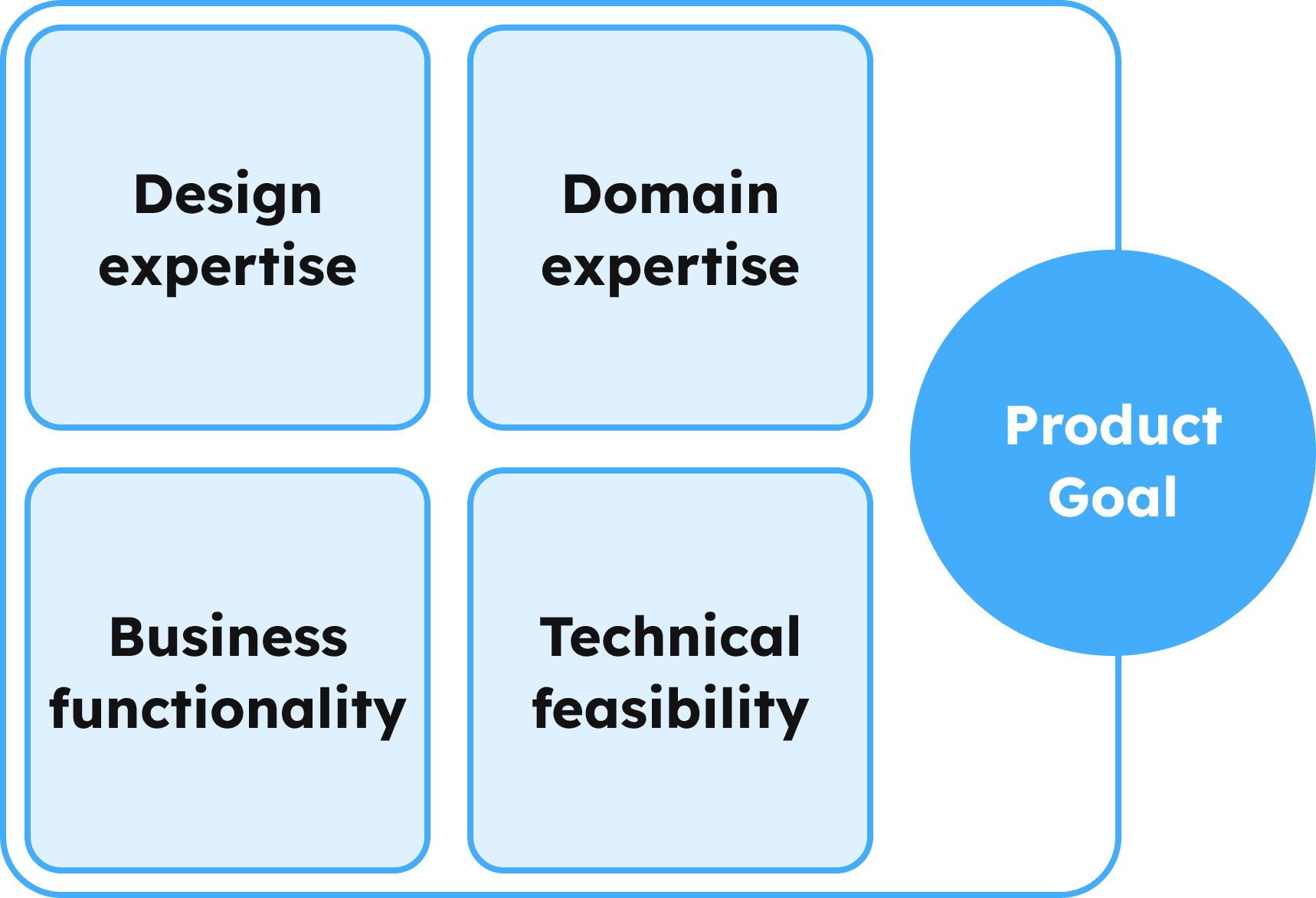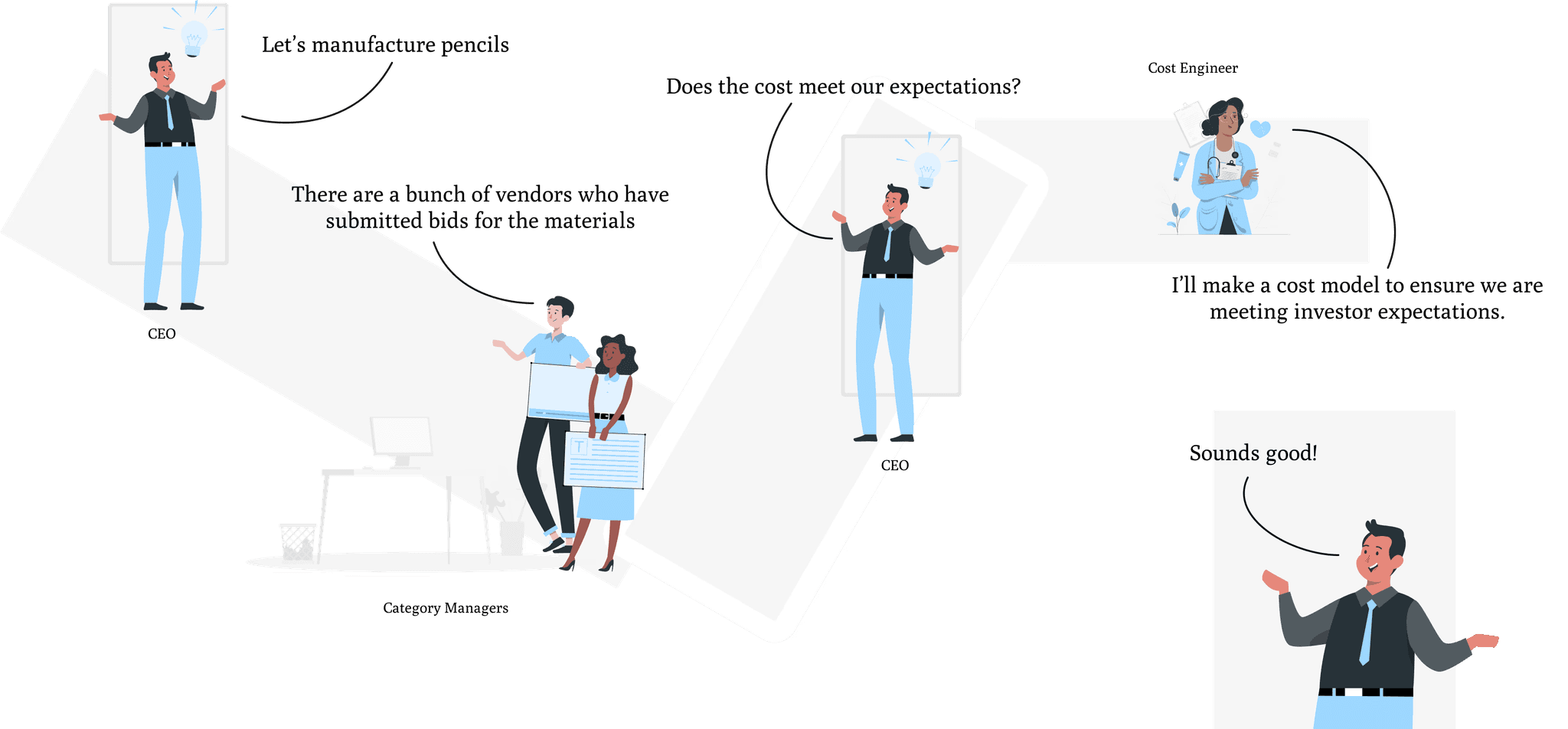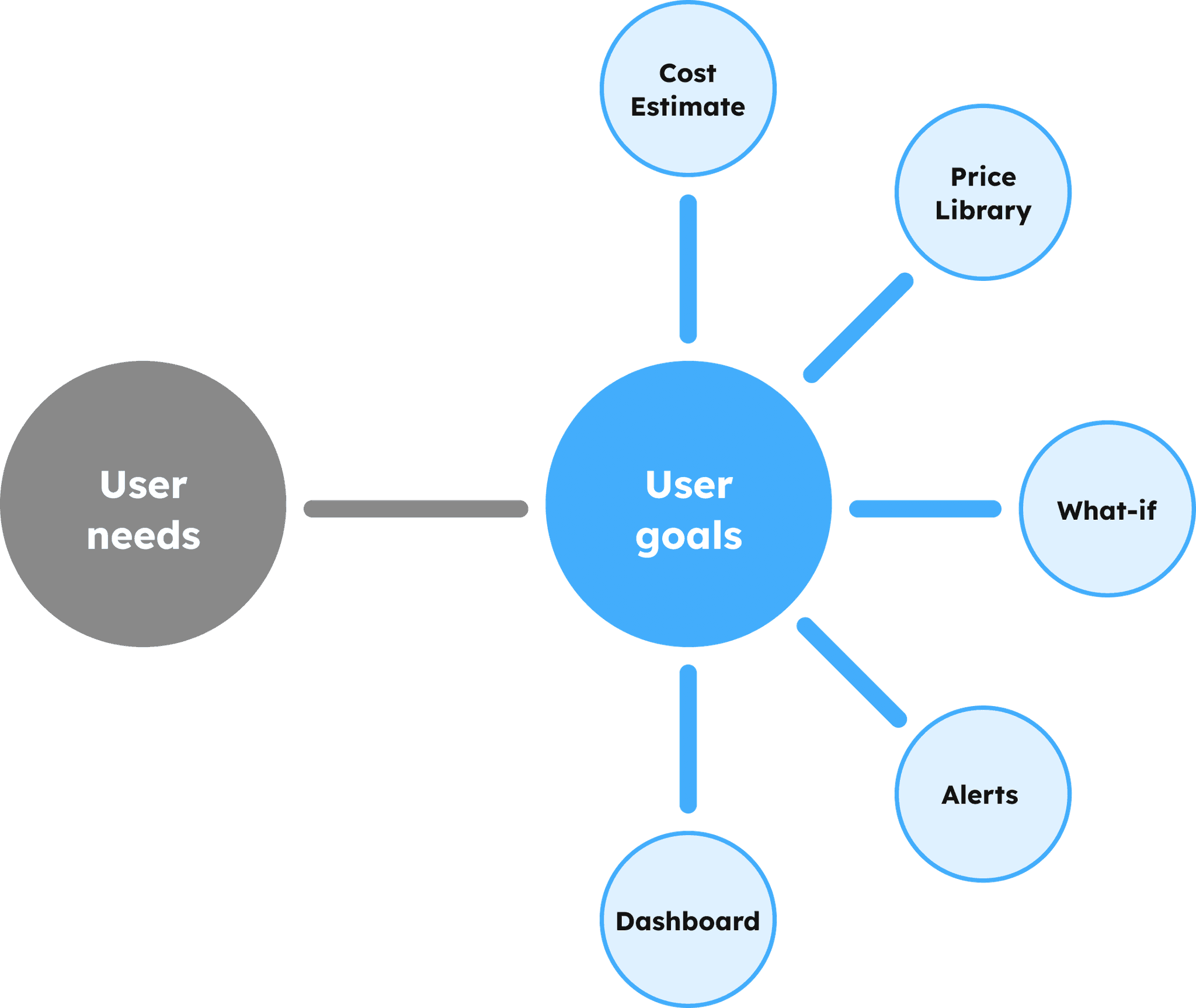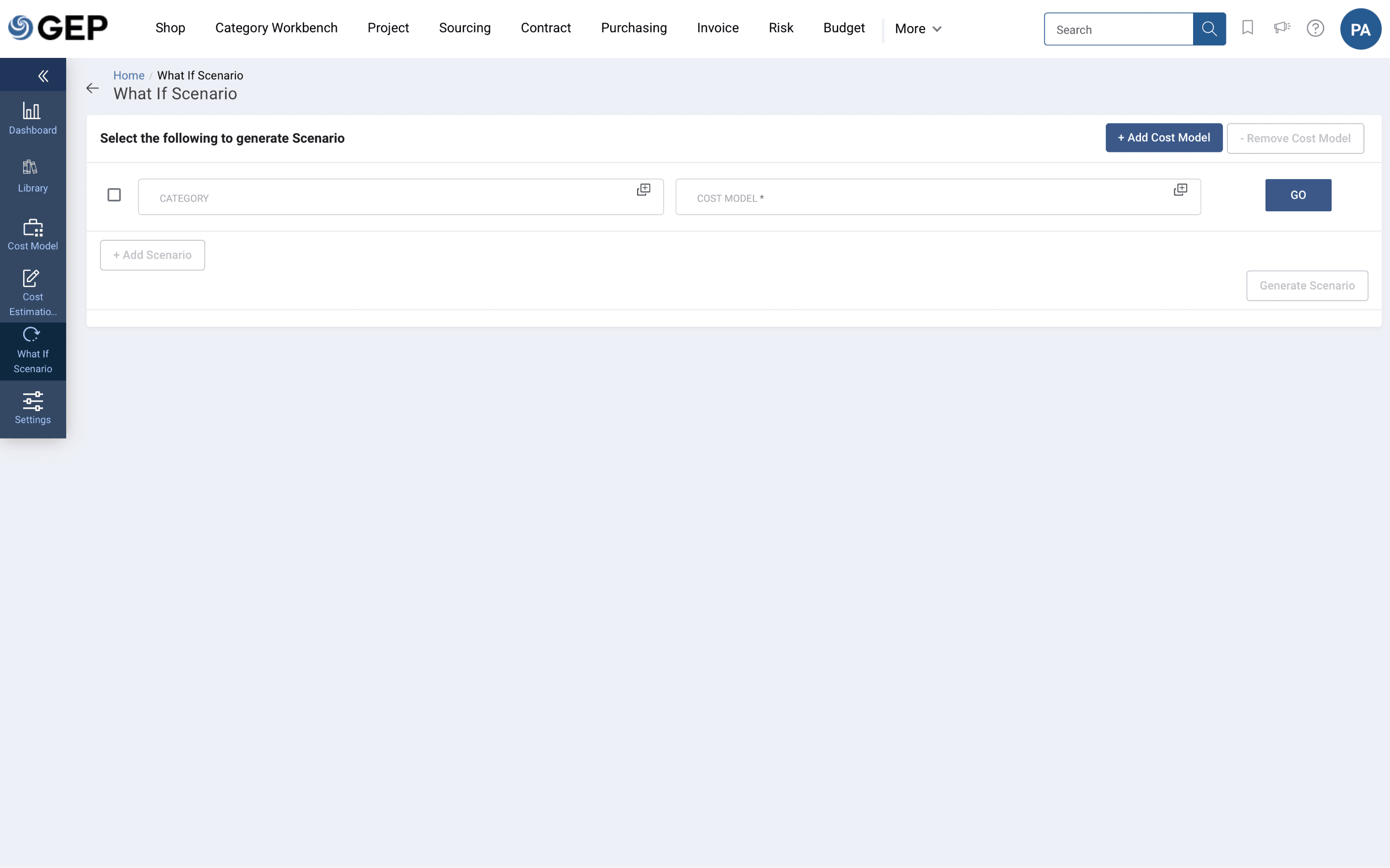Cost Analytics @ GEP
Redesigning the user experience for a cost analytics platform to increase usability, adoption and tight integration among sourcing teams.
I came in at a time when the design team was transitioning to a new design system. The product handed over to me to enable this transition was Cost Analytics, and I was tasked with introducing B2C experiences into B2B apps.
Role
UX Designer
Team
1 Senior UX Designer
2 Product Managers
Tools
Figma
Methods
Proto personas
Jobs To Be Done
Heuristic Evaluation
Journey Mapping
Iterative Prototyping
Overview
Tools should never hinder ability. Ensuring stakeholders have the right tools for cost management is crucial for unlocking maximum business value.
Problem
Category Managers & Cost Engineers have a variety of tools at their disposal to estimate costs of sourcing resources. But the learning curve on these tools is high, increasing time required by new users with solid fundamentals to create impact.
Solution
Given the freedom to experiment with designs that are not limited by legacy standards, we introduced design features and redefined flows typically found in consumer facing applications to reduce the learning curve and increase time spent creating business value.
Final application design
Support cost decisions effectively.
Cost Analytics provides a suite a tools that equips stakeholders to identify trends, stay up to date with markets and plan for a variety of scenarios, facilitating organisations to make bold and calculated decisions.






Identify market trends
Source resources cost effectively with the highlighted market trends and maximise margins.
Stay up to date with Alerts
Setup alerts to stay up to date and get notified of fluctuations in market indices.
Plan for adversity
Prepare for unforeseen scenarios by exploring and visualising variations in cost models with What-if modelling.
Monitor with an AI-powered dashboard
Monitor everything important, and receive and AI powered overview of the most consequential fluctuations.
Business Impact
16%
Improvement in likability scores
500+
New cost models created within 2 weeks of launch
⏫
Increased product stickiness
So how did we get to this?
Collaboration process

Design is about maximising the constraints present. There were four areas I needed to leverage to deliver solid and user-centric solutions. While I could reliably call upon my design expertise, and had clarity about the business requirement, I lacked domain expertise in supply chain management, and had to adapt to technical limitations as and when the tech team brought them up.
A preliminary product roadmap for the release of various features was created by the product team before the start of the internship. Once I was onboarded, I was able to use the roadmap to get a better understanding of the space.
However, since my understanding of the field was exponentially improving, it lead to a cycle where the business requirements informed the research I did, which improved my understanding of the user's motivations and jobs to be done statements, which influenced the design outcomes we hoped to achieve.

In reality, the formative research was more like this…
Gather requirements
Secondary research
Persona creation
Explorations + Design
Understanding who we were designing for and what they required was akin to piecing a puzzle together.
Each piece that fit gave more information about how the other pieces interact with each other.
The puzzle did get pieced together, so let's take a closer look at the idiosyncrasies in the world of supply chain management.
What is Sourcing?
Sourcing is the process used to identify, evaluate, and acquire items required by organisations to conduct operations.
When an organisation decides to manufacture a new product, they start by understanding the cost opportunities involved. They requests tenders from suppliers of the materials, which enables them to figure who can supply which materials at the best costs. This process of knowledge building to negotiate the best prices is the initial part of the process of sourcing.

Where does Cost Analytics fit into this?
After suppliers submit bids, organisations need to negotiate with them for a good deal. But how do they know what a good deal is, when they have never procured from such a market? What really is a bargain without historic information? This is exactly what Cost Analysis is for. By leveraging market indices and price libraries, and simulating all potential cost drivers, organisations are able to determine what a product should cost. This information is used to negotiate with potential suppliers, allowing the organisation to stay in control of their budgets and margins.
Cost Analytics enables organisations to have a competitive edge during negotiations by ensuring all decisions taken are well informed.

Understanding the stakeholders
Users for the application were not readily accessible for primary formative research, so we had to get creative to understand the user's needs. We approached this by analysing business requirements from clients and had multiple in-depth discussions with members of the product team who had worked closely with the users. With this, we created Jobs to be Done statements for the two major stakeholders identified.
01
Category Managers
Source materials for their organisation fom suppliers at the best possible price. They monitor category savings, identify cost opportunities, and take decisions on the overall purchase strategies that fall under their department.
Jobs to be Done
"When I receive quotes from suppliers, I want to compare the costs with the cost benchmark my cost engineer has created. This allows me to ensure that the costs are negotiated at a fair value and enables cost efficient sourcing of the materials."
"When I create a sourcing event, I want to set a baseline price so that I can ensure my organisation saves money by getting services and materials at reasonable price point."
"When markets fluctuate, I need to know which categories are impacted, and I want to understand the trend of the impact so that I can plan my sourcing activities around these factors."
"After I procure items, I want to know the should costs of materials so that I can have a cost prediction that will help me determine expected variation in cost opportunities."
02
Cost Engineers
Are the subject matter experts on costs. They digitise the breakdown of costs to be used by the category managers when sourcing items. They also model alternative scenarios to support the category managers.
Jobs to be Done
"I work closely with the R&D team to create cost models, ensuring cost visibility across all relevant stakeholders for new product launches. These cost models I create should be able to incorporate all the potential costs that could arise over the duration of a product's life cycle."
"I want to be able to modify cost structures as and when manufacturing processes change, so that the stakeholders are always up to date with the should costs of the products."
"I want to be able to further anticipate potential changes in market conditions and visualise the impact on my expected costs. This will allow me to stay prepared in case of any unexpected developments and effectively negotiate with the supplier for favourable cost outcomes."
With this, we created a flow for what and how information would would flow between the two major stakeholders.

Through these processes, we understood that the cost engineer is primarily an anchor, supporting the category managers by enabling them to take informed decisions regarding which suppliers get awarded the contract.
Problem statement
How can we enable Cost Engineers to effectively support various Category Managers in their decision making processes?
What did the Cost Engineers need?
01
Vendor Negotiation Tools
A more integrated approach was necessary when considering further development of vendor negotiations that enabled comprehensive preparation.
02
Market trends alerts
More robust and omni-present market trends notification system was required to enable cost engineers to take proactive decisions.
03
Contingency planning
Cost Engineers needed more versatile tools to seek out and plan for unforeseen contingencies.
04
Improved monitoring and alignment
Cost engineers needed a solution to monitor the most important cost sensitive factors and help other internal stakeholders stay aligned with the financial direction
How did it come together?

Once we realised that the various features of the product were independent of each other, enabling the stakeholders to achieve different goals, much like a variety of tools for different tasks, the to-do list started getting chalked off with incredible pace.
Let's take a look at how this worked with an example of What-if modelling.
Business Need
Make the complex B2B experiences more user friendly, such that a first time user would also be able to seamlessly use the product, while incorporating all the elements that made the design functional.
What did the Cost Engineers need? Well, the Jobs to be Done statement gave us an idea.
"I want to be able to further anticipate potential changes in market conditions and visualise the impact on my expected costs. This will allow me to stay prepared in case of any unexpected developments and effectively negotiate with the supplier for favourable cost outcomes."
Why were they finding it difficult to do so currently?
To understand this, I broke down the problems they were facing with the existing interface.

It is unclear what a user has to do or how they do it when they open the software.
There are multiple primary actions available, which can confuse the user. It is also unclear whether the user clicks go, or should add a scenario to generate the what-if scenarios.
In light of these challenges, there were three major changes we needed to make.
01
The steps needed to create the scenarios needed to be chunked, with actions possible clearly stated.
02
There was a need to allow for a more intuitive manipulation of the values within the conditions.
03
Current values, changed conditional values needed visualisation for easier interpretation. We also realised there was the possibility to present historical values for additional comparison, enabling comprehensive decision making.
So how did we address these challenges?
01
We chunked the different activities - first only letting the user select the elements they want to play with.The steps required were also clearly mentioned using a stepper component. The buttons also indicated which step the user would proceed to, keeping the user informed about system status.

02
The Playground utilised simple to understand tools to manipulate the values - a slider for finite values and an input field for infinite values.

03
We worked with the tech and product teams to ensure that manipulating the values results in immediately viewable changes.

This process was repeated for each of the five product features we designed.
Understand user goals through the jobs to be done
Identify why the current product makes it challenging to achieve the goals
Refer to competitors and other analogous solutions to mitigate the challenges
Verify the validity of usability of the design with domain experts
Conclusion and Learnings
Being in a new field, I learnt to look at ambiguity as an opportunity to differentiate my designs from competitors.
01
Verifying assumptions
It saves a lot of time and effort to verify assumptions before designing a solution.
02
Accepting ambiguity
Being comfortable not knowing everything about your user, and being able to revisit a feature to make the necessary changes based on updated understanding is critical.
03
Simple... yet complex
Creating simple designs is essential to designing highly functional products. But it is important to know when adding certain amount of complexity can help with the functionality.
04
Context
Understanding the context within the which the product is used is key to designing novel, yet familiar experiences. Understanding the field, the way information arrives, and the way competitors build their products contributes to a highly contextual understanding.
05
Differentiation
Finding the one singular factor that defines the problem is of utmost importance, as tackling this can elevate the experience and help differentiate the design from competitors.
Get in touch



